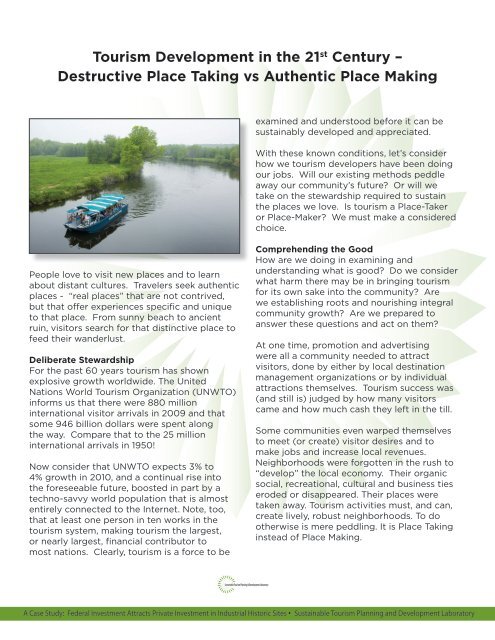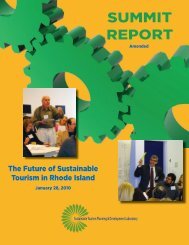Tourism Development in the 21st Century – Destructive Place ...
Tourism Development in the 21st Century – Destructive Place ...
Tourism Development in the 21st Century – Destructive Place ...
You also want an ePaper? Increase the reach of your titles
YUMPU automatically turns print PDFs into web optimized ePapers that Google loves.
<strong>Tourism</strong> <strong>Development</strong> <strong>in</strong> <strong>the</strong> 21 st <strong>Century</strong> <strong>–</strong><br />
<strong>Destructive</strong> <strong>Place</strong> Tak<strong>in</strong>g vs Au<strong>the</strong>ntic <strong>Place</strong> Mak<strong>in</strong>g<br />
exam<strong>in</strong>ed and understood before it can be<br />
susta<strong>in</strong>ably developed and appreciated.<br />
With <strong>the</strong>se known conditions, let’s consider<br />
how we tourism developers have been do<strong>in</strong>g<br />
our jobs. Will our exist<strong>in</strong>g methods peddle<br />
away our community’s future? Or will we<br />
take on <strong>the</strong> stewardship required to susta<strong>in</strong><br />
<strong>the</strong> places we love. Is tourism a <strong>Place</strong>-Taker<br />
or <strong>Place</strong>-Maker? We must make a considered<br />
choice.<br />
People love to visit new places and to learn<br />
about distant cultures. Travelers seek au<strong>the</strong>ntic<br />
places - “real places” that are not contrived,<br />
but that offer experiences specific and unique<br />
to that place. From sunny beach to ancient<br />
ru<strong>in</strong>, visitors search for that dist<strong>in</strong>ctive place to<br />
feed <strong>the</strong>ir wanderlust.<br />
Deliberate Stewardship<br />
For <strong>the</strong> past 60 years tourism has shown<br />
explosive growth worldwide. The United<br />
Nations World <strong>Tourism</strong> Organization (UNWTO)<br />
<strong>in</strong>forms us that <strong>the</strong>re were 880 million<br />
<strong>in</strong>ternational visitor arrivals <strong>in</strong> 2009 and that<br />
some 946 billion dollars were spent along<br />
<strong>the</strong> way. Compare that to <strong>the</strong> 25 million<br />
<strong>in</strong>ternational arrivals <strong>in</strong> 1950!<br />
Now consider that UNWTO expects 3% to<br />
4% growth <strong>in</strong> 2010, and a cont<strong>in</strong>ual rise <strong>in</strong>to<br />
<strong>the</strong> foreseeable future, boosted <strong>in</strong> part by a<br />
techno-savvy world population that is almost<br />
entirely connected to <strong>the</strong> Internet. Note, too,<br />
that at least one person <strong>in</strong> ten works <strong>in</strong> <strong>the</strong><br />
tourism system, mak<strong>in</strong>g tourism <strong>the</strong> largest,<br />
or nearly largest, f<strong>in</strong>ancial contributor to<br />
most nations. Clearly, tourism is a force to be<br />
Comprehend<strong>in</strong>g <strong>the</strong> Good<br />
How are we do<strong>in</strong>g <strong>in</strong> exam<strong>in</strong><strong>in</strong>g and<br />
understand<strong>in</strong>g what is good? Do we consider<br />
what harm <strong>the</strong>re may be <strong>in</strong> br<strong>in</strong>g<strong>in</strong>g tourism<br />
for its own sake <strong>in</strong>to <strong>the</strong> community? Are<br />
we establish<strong>in</strong>g roots and nourish<strong>in</strong>g <strong>in</strong>tegral<br />
community growth? Are we prepared to<br />
answer <strong>the</strong>se questions and act on <strong>the</strong>m?<br />
At one time, promotion and advertis<strong>in</strong>g<br />
were all a community needed to attract<br />
visitors, done by ei<strong>the</strong>r by local dest<strong>in</strong>ation<br />
management organizations or by <strong>in</strong>dividual<br />
attractions <strong>the</strong>mselves. <strong>Tourism</strong> success was<br />
(and still is) judged by how many visitors<br />
came and how much cash <strong>the</strong>y left <strong>in</strong> <strong>the</strong> till.<br />
Some communities even warped <strong>the</strong>mselves<br />
to meet (or create) visitor desires and to<br />
make jobs and <strong>in</strong>crease local revenues.<br />
Neighborhoods were forgotten <strong>in</strong> <strong>the</strong> rush to<br />
“develop” <strong>the</strong> local economy. Their organic<br />
social, recreational, cultural and bus<strong>in</strong>ess ties<br />
eroded or disappeared. Their places were<br />
taken away. <strong>Tourism</strong> activities must, and can,<br />
create lively, robust neighborhoods. To do<br />
o<strong>the</strong>rwise is mere peddl<strong>in</strong>g. It is <strong>Place</strong> Tak<strong>in</strong>g<br />
<strong>in</strong>stead of <strong>Place</strong> Mak<strong>in</strong>g.<br />
A Case Study: Federal Investment Attracts Private Investment <strong>in</strong> Industrial Historic Sites • Susta<strong>in</strong>able <strong>Tourism</strong> Plann<strong>in</strong>g and <strong>Development</strong> Laboratory
Mak<strong>in</strong>g <strong>the</strong> Grade<br />
<strong>Tourism</strong> higher education came <strong>in</strong>to be<strong>in</strong>g<br />
<strong>in</strong> <strong>the</strong> early 1970’s. It studies <strong>the</strong> subject<br />
as a science. Common thought was that<br />
promotion and market<strong>in</strong>g would attract<br />
visitors for economic ga<strong>in</strong>. Initial courses<br />
placed emphasis on <strong>the</strong>se subjects, along<br />
with management, travel and hospitality.<br />
Miss<strong>in</strong>g were courses <strong>in</strong> tourism plann<strong>in</strong>g and<br />
development.<br />
<strong>Tourism</strong> students today must study and<br />
understand land-use, community plann<strong>in</strong>g<br />
and susta<strong>in</strong>ability. They must exam<strong>in</strong>e that<br />
tourism unfettered can leave a community “<strong>in</strong><br />
a pickle” with traffic congestion, unau<strong>the</strong>ntic<br />
improvements, pollution and faceless<br />
development. And once a community<br />
becomes a pickle it can not go back to be<strong>in</strong>g<br />
a cucumber. To avoid putt<strong>in</strong>g communities<br />
at risk, we must teach prospective tourism<br />
professionals new fundamental pr<strong>in</strong>ciples.<br />
of life and are “hospitable, au<strong>the</strong>ntic and<br />
dist<strong>in</strong>ctive.” Such communities empower and<br />
engage residents. They are water and energy<br />
efficient, and disaster resilient. This def<strong>in</strong>ition<br />
reveals a shift to <strong>the</strong> new paradigm of tourism<br />
development as place mak<strong>in</strong>g.<br />
The <strong>the</strong>ory of Geotourism, authored by<br />
Jonathan Tourtellot of National Geographic<br />
Society’s Center for Susta<strong>in</strong>able Dest<strong>in</strong>ations,<br />
is that tourism susta<strong>in</strong>s or enhances <strong>the</strong><br />
geographical character of a place and <strong>the</strong><br />
The tourism professionals of <strong>the</strong> future<br />
cannot simply promote a place until it<br />
becomes a dest<strong>in</strong>ation. They must seek<br />
to partner with its residents, bus<strong>in</strong>esses,<br />
government and agencies. They must be<br />
taught that tourism development requires<br />
objective guidance and that <strong>the</strong> true bottoml<strong>in</strong>e<br />
of well managed tourism is <strong>in</strong>tegrated<br />
place-mak<strong>in</strong>g based on <strong>the</strong> au<strong>the</strong>nticity and<br />
values of <strong>the</strong> community.<br />
Putt<strong>in</strong>g Theories to <strong>the</strong> Test<br />
It is past time to f<strong>in</strong>d new ways for<br />
communities to become great places to live,<br />
to work and to visit. New <strong>the</strong>ories suggest<br />
that <strong>the</strong> residents should benefit first and<br />
most from tourism development; a result<br />
obta<strong>in</strong>ed when we first preserve and protect<br />
and <strong>the</strong>n promote our places.<br />
Theories are emerg<strong>in</strong>g that communities are<br />
eager to test. Some apply <strong>the</strong> pr<strong>in</strong>ciples of<br />
“whole community plann<strong>in</strong>g.” As articulated<br />
by Kip Bergstrom, founder of Re-<strong>in</strong>vent<strong>in</strong>g<br />
Stamford (CT), whole communities are full<br />
well be<strong>in</strong>g of its residents. It provides local<br />
<strong>in</strong>centive to protect what tourists come to<br />
see. Geotourism focuses on <strong>the</strong> place as a<br />
whole.<br />
Civic <strong>Tourism</strong>, developed by Dr. Dan<br />
Shill<strong>in</strong>g of Arizona State University, proffers<br />
that we must reverse our th<strong>in</strong>k<strong>in</strong>g about<br />
tourism from economic juggernaut to<br />
A Case Study: Federal Investment Attracts Private Investment <strong>in</strong> Industrial Historic Sites • Susta<strong>in</strong>able <strong>Tourism</strong> Plann<strong>in</strong>g and <strong>Development</strong> Laboratory
esponsible corporate citizen, enhanc<strong>in</strong>g<br />
<strong>the</strong> cultural, built, and natural environment,<br />
thus preserv<strong>in</strong>g cultures, protect<strong>in</strong>g <strong>the</strong><br />
environment and sav<strong>in</strong>g historic districts.<br />
More than be<strong>in</strong>g an economic tool, Civic<br />
<strong>Tourism</strong> aims to enable healthy place-mak<strong>in</strong>g.<br />
Accord<strong>in</strong>g to Dr. Martha Honey of <strong>the</strong> Center<br />
for Responsible Travel, <strong>the</strong> mission of her<br />
organization is to improve ecotourism us<strong>in</strong>g<br />
susta<strong>in</strong>able tourism practices and pr<strong>in</strong>ciples.<br />
The Center’s research focuses on tourism as<br />
a tool for poverty alleviation and biodiversity<br />
conservation while <strong>in</strong>corporat<strong>in</strong>g socially and<br />
environmentally responsible practices.<br />
Costas Christ, of <strong>the</strong> World Travel and<br />
<strong>Tourism</strong> Council submits that susta<strong>in</strong>able<br />
tourism is <strong>the</strong> <strong>in</strong>tegration of, and balance<br />
between, economic and environmental<br />
concerns. Ideal susta<strong>in</strong>ability encourages<br />
<strong>the</strong> environment to flourish while tourism<br />
activities provide a net environmental ga<strong>in</strong>.<br />
Options and Challenge<br />
As residents or visitors, we can preserve <strong>the</strong><br />
places we love and those we yearn to discover.<br />
Options are emerg<strong>in</strong>g for a new type of tourism<br />
and a new type of tourism management to<br />
take on <strong>the</strong> challenge. Ra<strong>the</strong>r than treat<strong>in</strong>g<br />
our places like commodities, we must work to<br />
<strong>in</strong>tegrate social and economic development,<br />
effectively plann<strong>in</strong>g, manag<strong>in</strong>g and mak<strong>in</strong>g<br />
healthy places build<strong>in</strong>g on <strong>the</strong> au<strong>the</strong>nticity of<br />
<strong>the</strong> community.<br />
Dr. Robert Bill<strong>in</strong>gton is <strong>the</strong> President of <strong>the</strong><br />
Blackstone Valley <strong>Tourism</strong> Council and <strong>the</strong><br />
Susta<strong>in</strong>able <strong>Tourism</strong> Plann<strong>in</strong>g and <strong>Development</strong><br />
Laboratory. He founded and lead <strong>the</strong> Council<br />
for 25 years. These organizations are based <strong>in</strong><br />
Blackstone Valley, Rhode Island, USA.<br />
http://www.changemakers.com/en-us/<br />
competitions/browse/all<br />
http://www.changemakers.com/en-us/<br />
Revelation<br />
A Case Study: Federal Investment Attracts Private Investment <strong>in</strong> Industrial Historic Sites • Susta<strong>in</strong>able <strong>Tourism</strong> Plann<strong>in</strong>g and <strong>Development</strong> Laboratory





